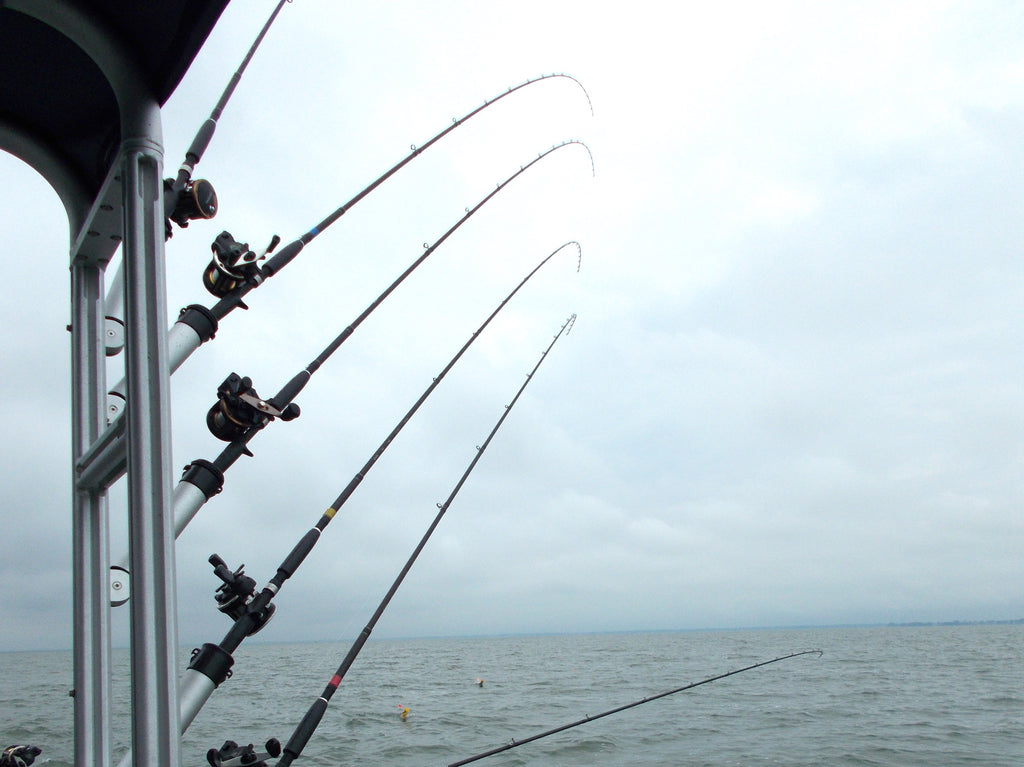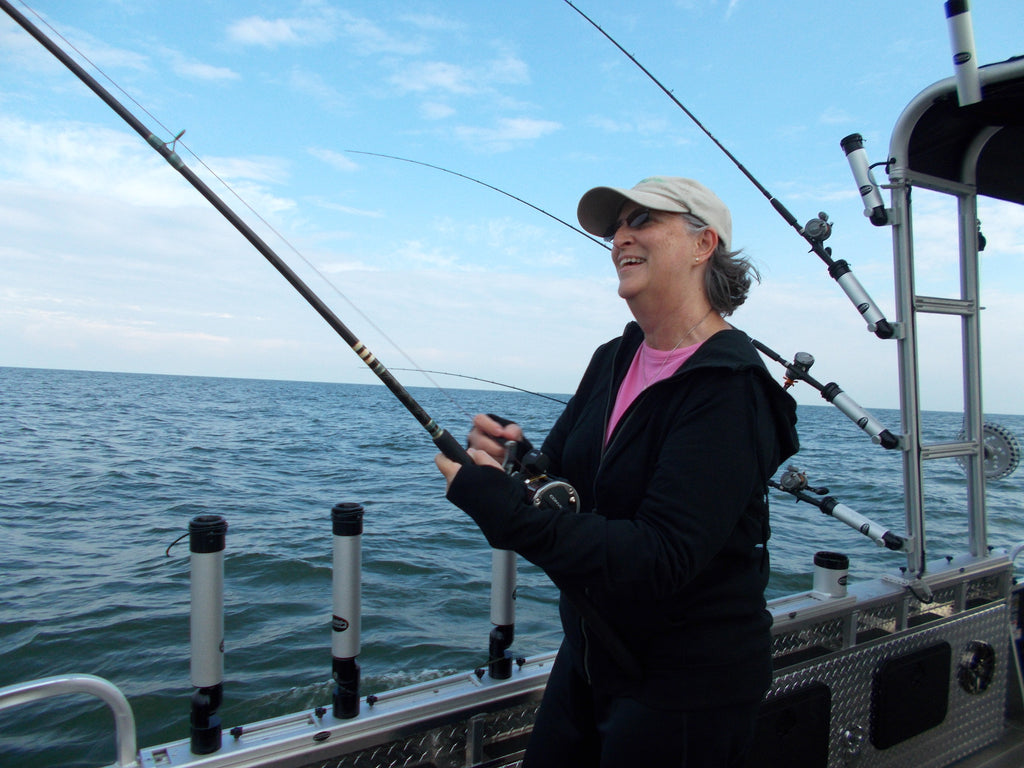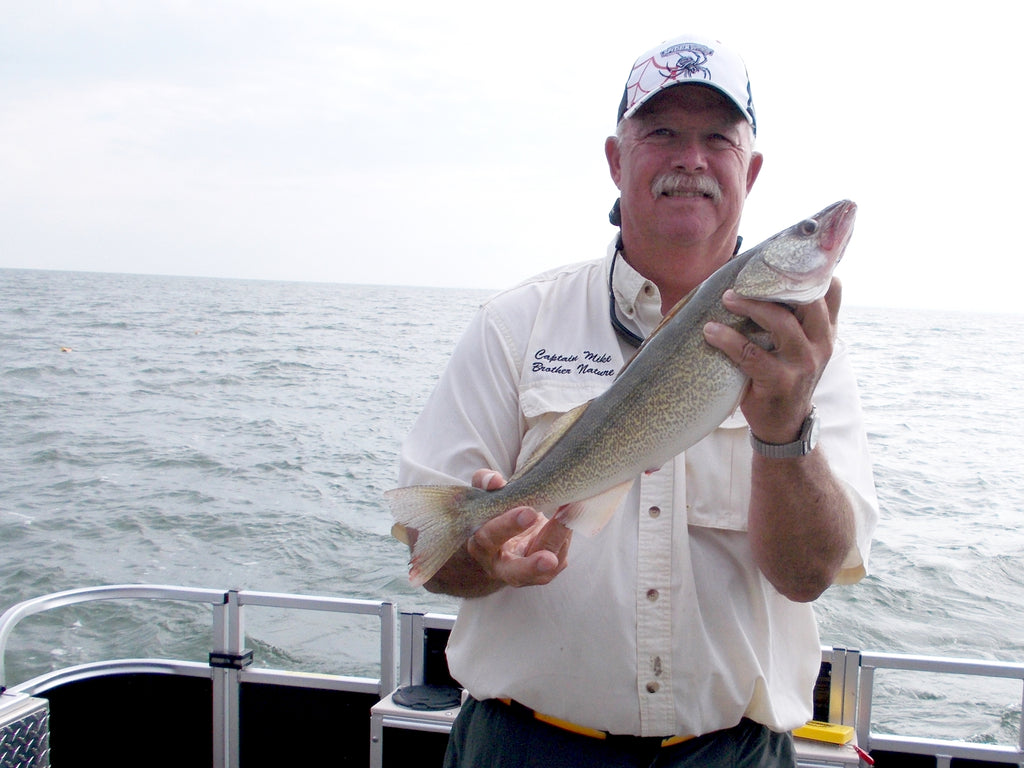“It’s a number’s game.” Lance said. “It’s not the way most guys do it. It’s not the way I used to do it. But if you just do the math, it makes sense and when you look in my livewell at the end of the day, the numbers in there show fishing with the odds in your favor wins out most of the time.”
That’s what walleye pro, turned walleye educator, turned walleye guide—just call him a walleye entrepreneur—Lance Valentine told me last July.
I fished Saginaw Bay with Lance to experience big water fishing on a pontoon boat. Valentine fishes Sag Bay on a Angler Qwest 824 Pro Troll.
As eye opening as the pontoon boat experience was, his “numbers game” fishing was equally revealing. It involves finding the part of the water column where the lures being trolled are getting the most hits, putting the maximum number of lures in that zone, then upping those odds by speeding up the troll to make sure those lures swim by more walleyes.

Valentine puts all the lures on one side of his boat at the same depth.
Key number one, lure speed.
Everyone knows (or assumes or has been taught) walleyes will only bite a “lazy” lure. How many times have you heard the importance of having a boat which will slow down to walleye speed—walleye speed normally being something under two miles per hour and often half that.
How about twice that? “I troll a couple tenths of a mile per hour either side of four miles per hour.” Valentine explained.
“It’s easy math,” he continued. “Here on Saginaw Bay, most places on Lake Erie or at other lakes where walleyes suspend over vast reaches of open lake with little if any structure, fishermen use trolling tactics primarily to just cover a lot of water.
However you prefer to visualize it, whether it’s so many walleye per mile or so many walleye per acre of water, it doesn’t matter. When I’m going twice as fast, I’m covering twice as many miles or cutting a swath through twice as many acres of water than the guy trolling at half my speed—at what is considered to be a normal trolling speed. When I show my lures to twice as many active walleyes, it makes sense I catch more of them.”

How fast is your walleye speed? If it’s not close to or over 4 mph you are missing out.
Will they bite a lure going that fast? Of course they will. Anyone who has ever trolled much with planer boards has undoubtedly caught fish when the boat is turning and the outside lures are pulling through the water much faster than when trolling straight ahead.
How much faster?
The exact speed doesn’t matter or if it does, you do the math.
I’m sure there’s a complicated mathematical formula involving pi and other numbers you can use to calculate the MPH of those lures. What does matter is a common rule of thumb trollers often follow. If bites are coming when the boat is turning either speed up or slow down when going back to a straight course. Boost the trolling speed if the bites are coming on the outside lines, slow down if the bites are coming on the inside lines.
Realistically, the difference isn’t so much attributable to speed as it is lure action and depth. The fish aren’t swimming around looking for a meal going 1.8 mph to the point they will shun anything swimming at 2.2. They are just looking for something that looks good to eat and they can catch.
Don’t worry about them being able to catch it. Walleyes aren’t speedsters, but neither are 260 pound line backers on a football team. The big guys, given an angle, regularly bowl over 170 pound halfbacks in the open field. Walleyes can catch your fast moving lure if they think it looks good to eat.
I’m sure one of the reasons the term “walleye speed” was coined had to do with lure action rather than walleye preference. Many of the baits and plenty of lures that look good-to-eat at slow speeds don’t look (or sound) like walleye fodder when trolled above a certain speed.
Valentine’s go to lure for trolling that fast is Flicker Shads. He used a variety of colors the day I fished with him, but all the same #7 size (size may vary with the time of year). “Flicker Shads are great lures,” Valentine said. “And they troll perfectly straight at four miles per hour. Sure, there are other lures that will work at fast speeds and most lures can be tuned to run that fast. That’s not why I use all the same baits. All I’m doing is simplifying.”

The author’s wife Peg is the beneficiary of Valentines speed walleye tactics.
Fishermen tend to over think what’s going on under the waves and there are dozens of variables, big and small, to consider. Does it make a difference if the fishing line is monofilament or fluorocarbon? Is a 2 1/2-inch lure better than a 2 3/4-incher? Should the leader behind a Jet Diver or Dipsey Diver be 40 inches or 50? Does the color of the diver make a difference? Should the lure color be matched to the diver color? Does the lure color even matter? Is the color of the underwear I’m wearing make a difference?
The answer to all these questions (except for the underwear thing) is “sometimes.” More to the point, “sometimes” is a continuum going from almost never to quite frequently.
Many anglers head out trying to find the perfect lure, the perfect depth, the perfect speed and the perfect color or pattern to make the fish bite—all at the same time. I’ll admit to fishing that way, at times.
I try to cover as many of the variables as possible by positioning lures high, medium and low in the water column by mixing ‘riggers, divers, weighted line, lead core and copper wire at times. I may have spoons, flies and plugs out. It’s called covering the bases or the shotgun approach.
When a shotgunner catches a fish, which of the variables was it that coaxed the fish on the line?
Was it the particular lure?
Was it the speed?
Was is the color or depth?
If that fire-tiger lure that caught the fish was swimming 12 feet deep, would that fish have mistaken it for an edible baitfish if the lure had been swimming at 18 feet? Would it have even seen the lure? If a the first fish came on a spoon on a downrigger, should you put spoons on the divers? It’s trial and error and besides being confusing, it’s time consuming.
Will the trip be over before you figure it out?
Not Valentine. Lance further simplifies his already simplified lure selection process. Besides years of experience telling him likely areas and depths to fish, Valentine watches his sonar to make sure there are fish in the area he’s fishing. He’s much more interested in the marks showing suspended fish in the water column than the ones belly to bottom.
“Those suspended walleye are active fish, they are the ones most likely to bite trolled lures. And though a walleye will swim up to bite a lure passing overhead six or eight feet, undoubtedly more; I know I’ll get more bites by putting my lures in the narrow, three or four foot zone where the most active fish are suspended and feeding.”

“Covering the bases” anglers agree and will stagger the depths they are presenting their lures at the beginning of the day to let the fish “tell them” the perfect depth. So they use one lure that will troll 8 feet deep, another that will go 15 and use other tactics to put lures at other likely depths.
How long does it take to learn the 15 foot level is best? If there’s only one lure in the spread or on each side of the boat running at 15 feet it may take a long time. A walleye will certainly swim horizontally one way or another to chase a lure, but how far? If it will swim six feet but the lure is 10 feet away, you won’t catch it, you’ll never know the lure is at the perfect depth.
So what Valentine does on Sag Bay is match his sonar readings with experience and select the two most likely productive depths to sample first. This is more the “rifle” approach, than the shotgun. He puts all the lures trolling on one side of his boat at the one distinct depth and all the lures on the other side at different depth. He does this by using line counter reels and letting out specific amounts of monofilament before attaching his in-line planer to the line.
His simplified lure selection method described earlier makes this easy. Sure, he could consult tables and run lure X which will troll at 12 feet deep on 50 feet of line and deploy lure Y which the tables show will troll at 12 feet with 65 feet of line and so on.
“That introduces another whole level of complexity in setting the lures and then, when a fish does bite, was it the depth or was it the lure?” Valentine said. “By using identical lures, except color, I can zero in on the best depth and be certain the results aren’t being confused by other factors.”

Valentine varies the color of his lures, but uses all the same model and size to help keep things simple.
By putting all the lures on one side of the boat at the same depth, if that’s the “active-fish” zone, Valentine will know quickly.
No bites? Adjust them all higher or lower.
There’s a far greater chance of a fish spotting and striking three or four or five lures covering a wide swath of water than the chance of fish spotting just a single lure. If, in a short period, Valentine gets more bites on the lures trolling on lines set 40 feet behind the planers on one side than on the ones set 60 feet behind the boards on the other, he will adjust the lead-length on all of the lures on the less active side.
Once he gets all the lures in the active layer of water, he can then, need be, zero in on specific colors. “Most of the time, once I get all the lures into the strike zone, I’m getting enough action on all or most of them, I don’t even have to worry about switching from golds, to silvers, to painted,” he said.
That’s a good thing.
– written by Capt. Mike Schoonveld
SPEED TUNING
If you find your normal hard bodied baits won’t tolerate zipping through the water at “Valentine-speeds” and you don’t want to buy to lures that will troll fast and faster, just tune up your existing lures. Here’s how.
First, speed the boat up to the speed you want to troll, tie on the lure and let out five or six feet of line. Troll the lure along side the boat, out of any wake or turbulence, and watch the action. If the lure tries to swim on its side or even rolls over you will need to adjust the eye of the lure where the line, split ring or snap connects.

The rule to remember is: Bend the eye ring towards the bottom of the lake. If the lure swims or rolls starboard side up, bend the eye to the port side. Usually, just a tiny, often just a millimeter tweak or two, will put it right.








































